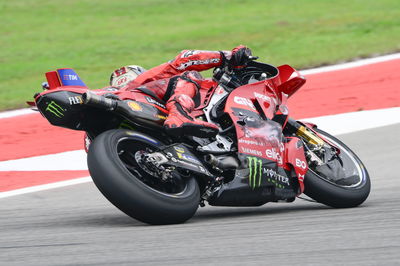Dunlop make a splash.
Dunlop broke new ground - and shifted plenty of water - at the Paul Ricard circuit near Marseille, France last week, with a first-ever dedicated wet test bringing together top teams from MotoGP, Superbike and Endurance for a two day programme at which multi-compound wet-weather tyres made their track debut.

Dunlop broke new ground - and shifted plenty of water - at the Paul Ricard circuit near Marseille, France last week, with a first-ever dedicated wet test bringing together top teams from MotoGP, Superbike and Endurance for a two day programme at which multi-compound wet-weather tyres made their track debut.
The tests brought the title-winning French SERT (Suzuki Endurance Racing Team) alongside the Tech 3 Yamaha MotoGP team and the Airwaves Ducati British Superbike squad - all lining up for the full spray treatment at the multi-million dollar Paul Ricard HTTT (High Tech Test Track) facility more usually dedicated to F1 and Le Mans race cars.
Riders Vincent Philippe, Matthieu Lagrive and Julian Costa for SERT, and Airwaves Ducati's Leon Haslam and Gregorio Lavilla rode for two days, working through a truckload of experimental Dunlop tyres to gather important data for future developments. Tech 3 Yamaha's new MotoGP rider, Sylvain Guintoli tested the 990cc MotoGP M1 Yamaha on the first day, but was unable to continue after falling and injuring his collarbone.
The riders covered more than 500 laps (1700 kms) over the two days, gathering a mass of data, downloaded from specialised GPS equipment developed in conjunction with the data recording experts at 2D, for detailed analysis by the seven strong team of Japanese and European tyre engineers, including compounding and construction specialists, attending the test.
The main thrust of development was in compounds, including the pioneering use of multi-compounded wets. This new development follows a trend already established with slick tyres, where as many as five different rubber compounds across the width of the tyre are required to meet the characteristics of specific circuits.
The engineering team was also experimenting with several new tread patterns, but the main area of focus was not on a fully wet track, but on a drying surface - those critical in-between conditions where races are often won or lost.
The Paul Ricard HTTT facility was ideal for these tests. At the press of a button, the circuit takes on the appearance of a massive irrigation scheme, as sprinklers soak the entire length of the 3.3 km lap that was chosen from the 180 different circuit layouts available in the complex.
"Track testing wet tyres at a normal test or race weekend is very difficult because you are always waiting for the weather, and conditions change from minute to minute making any scientific comparison or analysis virtually impossible," explained Dunlop's International Motorsport manager Jeremy Ferguson. "Here we can totally control and replicate the conditions, testing back-to-back in everything from the full wet to the almost dry.
"Dunlop is involved in more categories of racing than any of our competitors, and we want to move development forward in all of them. This year we have also made a seven-figure investment in purpose-built new generation manufacturing technology at our motorsport headquarters at Fort Dunlop in Birmingham, UK. These tests are part of that on-going programme aimed at delivering sustained, long term success in MotoGP and all other categories of motorcycle racing."












